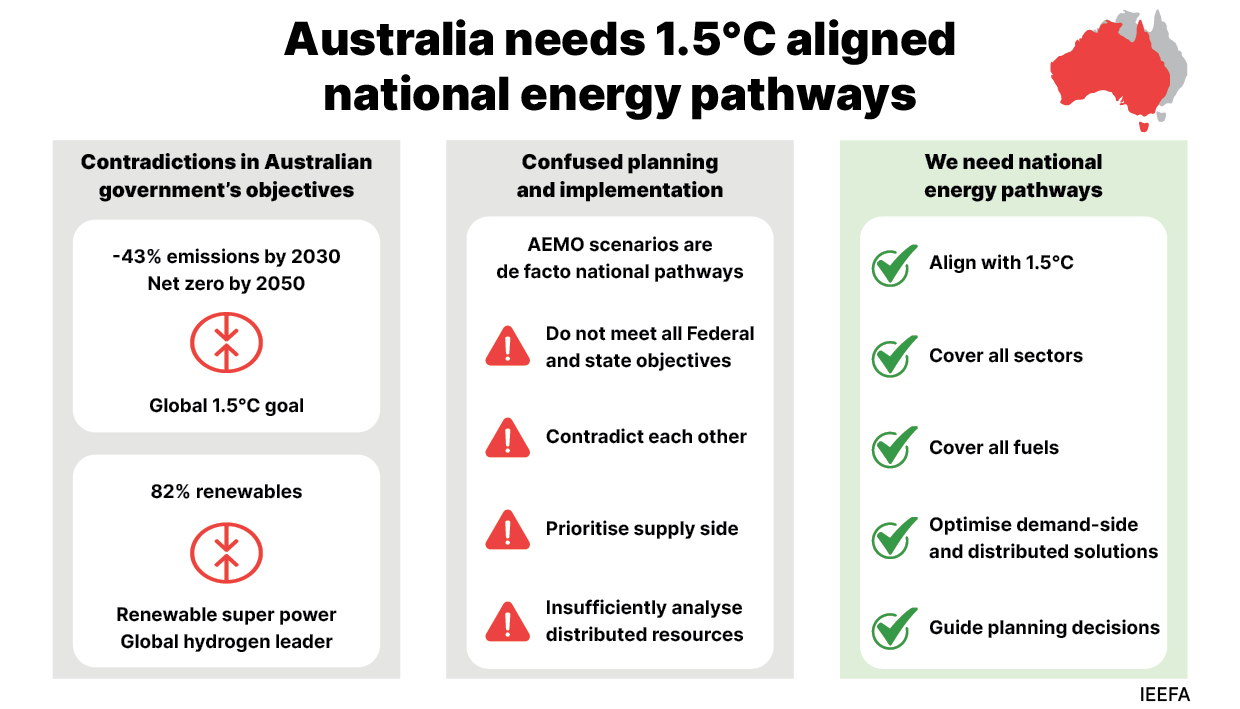Australia needs clear national energy pathways to 1.5°C not a maze

Contradictions and confusion abound in the absence of a cohesive energy transition strategy
Key Takeaways:
The Australian government’s climate objectives contradict each other, and it lacks a comprehensive plan for how it will achieve its emissions reduction goals.
AEMO’s scenarios are used as a de facto plan, but do not meet several government objectives and state targets, and make questionable assumptions and choices.
Australia needs 1.5°C national energy pathways that look at the energy transition in an integrated way across fuel types, sectors and solutions.
29 June 2023 (IEEFA Australia): The Australian government’s commitment to reduce greenhouse gas (GHG) emissions and develop renewable energy is full of good intentions but sadly lacking in a co-ordinated plan to meet its targets, a new report says.
Contradictions and inconsistencies between government objectives are creating confusion for industry and investors, according to the author, Amandine Denis-Ryan, chief executive of IEEFA Australia.
Australia has legislated both a net zero emissions target by 2050 and a target to reduce GHG emissions by 43% on 2005 levels by 2030. Multiple studies have found that Australia would need to cut its emissions by over 60% by 2030 and reach net zero before 2040 to align with the global goal of limiting climate change to 1.5°C above pre-industrial levels.
The federal government has announced several objectives, initiatives and pledges, backed by billions of taxpayer dollars, towards the country’s energy transition and emissions reductions yet it has not articulated how it will achieve its targets. In some cases there are no targets at all, such as ambitions on hydrogen production, methane emissions reduction, electric vehicle uptake and improving energy efficiency.
“Australia does not have a shared national view of how the transition will occur,” Ms Denis-Ryan says. “This is leading to confusion and discrepancies in the advice and decisions of government departments and agencies."
“To put it simply, the left hand of the government does not know what the right hand is doing,” she adds.
In the absence of an overarching national energy transition strategy, contradictory Australian Energy Market Operator scenarios are being relied upon heavily by public and private stakeholders even though they were not designed for this purpose.
“These scenarios were designed to support specific decisions in the electricity and gas markets,” Ms Denis-Ryan says. “Rather than being guided by the government, the likelihood of scenarios is rated by a panel of energy industry stakeholders.”
“There are a number of issues with those scenarios. The most likely scenario does not meet the 1.5°C objective, the government’s hydrogen ambitions and Victoria’s legislated emissions reduction targets. The scenario also has widely different forecasts for gas use in electricity generation in the gas- and electricity-focused publications.”
“Clean energy investors have questioned the assumption choices behind the only 1.5°C-aligned scenario modelling by AEMO, and have developed an alternative scenario that they consider to be more ‘practical and commercially credible’,” she adds.
National energy pathways should consider electricity and fuels transitions in an integrated way, and properly represent demand-side and distributed solutions.
“More emphasis should be put on demand-side solutions before concluding the need for more supply,” Ms Denis-Ryan says.
“Demand-side solutions can deliver multiple benefits for consumers and the economy, and are critical to achieving global climate goals.”
National energy pathways should support planning decisions, and make recommendations on which new supply projects are essential, on timelines for phasing out key infrastructure assets, and on priority usage for scarce resources. This should include both domestic energy requirements as well as export-focused projects.
Read the report: Australia needs 1.5°C aligned national energy pathways
Media contact: Amy Leiper, [email protected], 0414 643 446
Author contacts: Amandine Denis-Ryan, [email protected]; Jay Gordon, [email protected]
About IEEFA: The Institute for Energy Economics and Financial Analysis (IEEFA) examines issues related to energy markets, trends, and policies. The Institute’s mission is to accelerate the transition to a diverse, sustainable and profitable energy economy. (ieefa.org)












